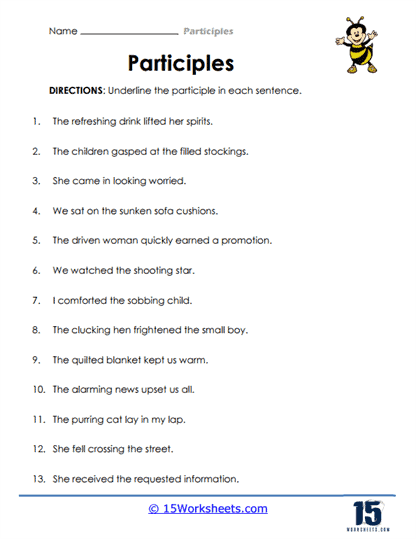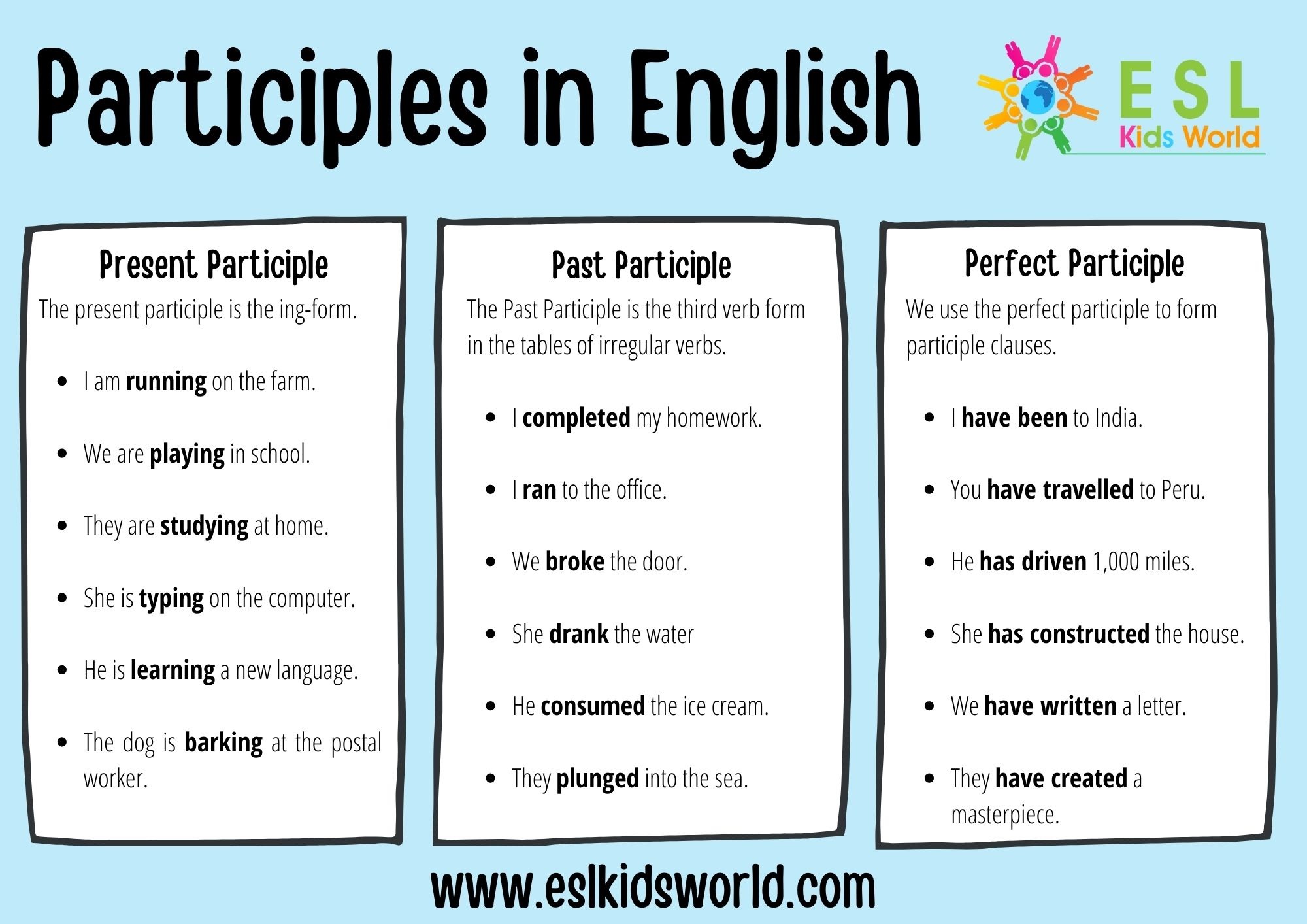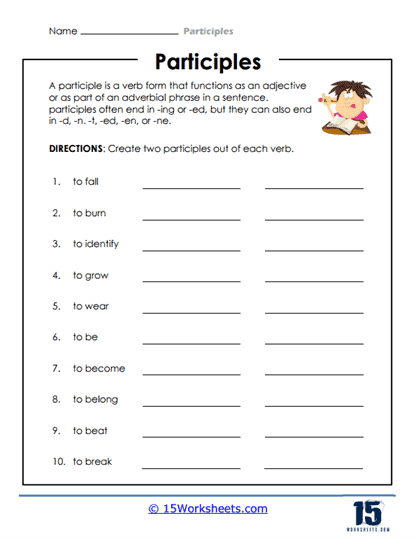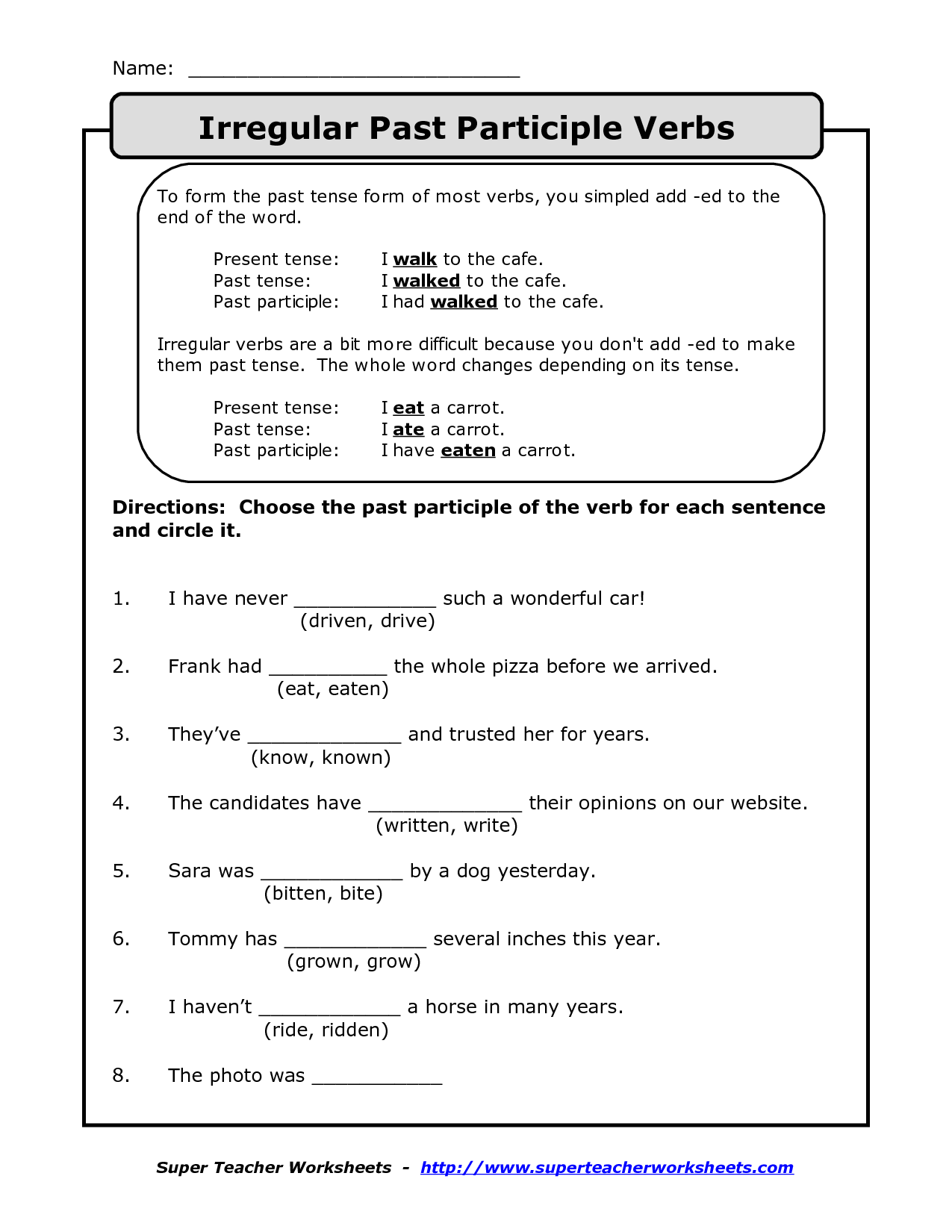
Mastering Participles: The Indispensable Role of Grammar Worksheets: Participles
In the intricate tapestry of the English language, verbs are the threads that create action and meaning. Yet, some verb forms possess a unique chameleon-like quality, adapting their function to enrich sentences in subtle yet powerful ways. These are participles – verb forms that can act as adjectives, be part of verb phrases, or even introduce participial phrases. While incredibly versatile, their dual nature often presents a significant hurdle for learners. This is where the strategic and well-designed use of Grammar Worksheets: Participles becomes not just beneficial, but truly indispensable.
Understanding and correctly employing participles is a hallmark of advanced English proficiency. They allow for more concise, elegant, and sophisticated writing and speaking. However, common pitfalls such as dangling modifiers, confusing participles with gerunds, and mastering irregular past participle forms can frustrate even dedicated students. This article will delve into the world of participles, explore why they pose challenges, and, most importantly, illustrate how targeted Grammar Worksheets: Participles provide the structured practice necessary to conquer these complexities.
What Exactly Are Participles? A Quick Refresher

Before we explore the power of worksheets, let’s briefly define our subject. Participles are non-finite verb forms, meaning they do not change according to the subject’s number or person. There are two primary types:

-

Present Participle (V-ing): Formed by adding "-ing" to the base form of a verb (e.g., running, singing, believing).

- As an Adjective: The barking dog woke me up. (Describes the dog)
- As Part of a Continuous Verb Tense: She is studying for her exams. (Part of the present continuous tense)
- In a Participial Phrase: Smiling broadly, he accepted the award. (Modifies "he")

-
Past Participle (V-ed or V3): Often ends in "-ed" for regular verbs (e.g., walked, finished, played), but has various irregular forms for irregular verbs (e.g., written, broken, seen, gone).
- As an Adjective: The broken vase lay on the floor. (Describes the vase)
- As Part of a Perfect Verb Tense: They have finished their homework. (Part of the present perfect tense)
- As Part of the Passive Voice: The book was written by a famous author. (Part of the passive voice)
- In a Participial Phrase: Written in haste, the note was hard to read. (Modifies "the note")



A third, less common type, is the Perfect Participle (having + past participle), which indicates an action completed before another (e.g., Having finished her work, she went home.).
Why Are Participles So Challenging for Learners?
The very versatility that makes participles so useful also makes them difficult to master. Here are some key reasons:
- The Adjective/Verb Dual Nature: Students often struggle to differentiate when a participle is acting as an adjective modifying a noun or pronoun versus when it’s part of a verb tense. For instance, "The running water" (adjective) vs. "He is running a marathon" (verb).
- Confusion with Gerunds: Both present participles and gerunds end in "-ing." However, gerunds function as nouns (Swimming is good exercise), while present participles function as adjectives or part of a verb phrase. This is a perpetual source of confusion.
- Irregular Past Participles: The English language is notorious for its irregular verbs. Memorizing the past participle forms of verbs like go (gone), see (seen), break (broken), speak (spoken), etc., requires significant effort and consistent exposure.
- Dangling and Misplaced Modifiers: Perhaps the most common and grammatically egregious errors involving participles. A participial phrase that doesn’t clearly and logically modify the subject of the sentence is "dangling." If it’s placed too far from the word it modifies, it’s "misplaced."
- Dangling: "Running down the street, the bus nearly hit me." (Implies the bus was running) – Correct: "Running down the street, I was nearly hit by the bus."
- Misplaced: "He saw a dog walking his bicycle." (Implies the dog was walking the bicycle) – Correct: "Walking his bicycle, he saw a dog."
- Passive Voice Construction: Past participles are integral to forming the passive voice, which can itself be a challenging concept for learners, particularly in distinguishing it from active voice constructions.
The Indispensable Role of Grammar Worksheets: Participles
Given these complexities, a structured and repetitive approach is essential for mastery. This is precisely where Grammar Worksheets: Participles shine. They offer a systematic and focused environment for learners to:
- Isolate and Focus: Worksheets allow learners to concentrate solely on participles without being overwhelmed by other grammatical structures. This isolation helps in solidifying understanding of their specific rules and functions.
- Reinforce Concepts through Repetition: Grammar learning is akin to building muscle memory. Repeated exposure and application of rules, provided by varied exercises on worksheets, helps transfer knowledge from short-term to long-term memory.
- Identify and Correct Errors: Worksheets provide a low-stakes environment for making mistakes. With answer keys, learners can immediately identify where they went wrong and understand why, facilitating self-correction and deeper learning.
- Practice Different Contexts: Effective worksheets present participles in various sentence structures and contexts, ensuring that learners can recognize and use them correctly in different situations, from simple sentences to complex paragraphs.
- Build Confidence: Successfully completing exercises on a worksheet provides a sense of accomplishment and builds confidence in one’s grammatical abilities, encouraging further engagement with the language.
Types of Exercises Found in Effective Grammar Worksheets: Participles
To address the multifaceted challenges of participles, a good set of worksheets will include a variety of exercise types:
-
Identification Drills:
- Underline all participles in a given set of sentences.
- Identify whether the participle is present or past.
- Determine if the participle is acting as an adjective, part of a verb phrase, or in a participial phrase.
- Purpose: Develop recognition skills and differentiate participle types.
-
Fill-in-the-Blanks:
- Provide sentences with blanks where learners must insert the correct present or past participle of a given verb.
- Often, these focus on irregular past participles (e.g., "The glass was ___ (break).").
- Purpose: Practice correct form usage, especially irregular verbs.
-
Gerund vs. Participle Distinction:
- Sentences where learners must identify if the "-ing" word is a gerund (noun) or a present participle (adjective/verb part).
- Purpose: Clarify a common point of confusion.
-
Sentence Combining/Reduction:
- Combine two simple sentences into one using a participial phrase (e.g., "She walked quickly. She was humming a tune." -> "Walking quickly, she was humming a tune.").
- Reduce relative clauses to participial phrases (e.g., "The boy who is sitting in the corner is my brother." -> "The boy sitting in the corner is my brother.").
- Purpose: Teach conciseness and stylistic variation, showing the practical application of participles.
-
Error Correction (Dangling/Misplaced Modifiers):
- Present sentences with common dangling or misplaced participle errors.
- Learners must rewrite the sentences to make the modification clear and logical.
- Purpose: Develop a critical eye for common errors and practice proper sentence construction.
-
Sentence Creation:
- Prompt learners to create their own sentences using specific participles or participial phrases, or to describe a picture using participles.
- Purpose: Encourage active production and creative application of the learned concepts.
-
Transformation Exercises:
- Convert active voice sentences into passive voice (requiring past participles).
- Convert sentences with adverbial clauses into sentences with participial phrases.
- Purpose: Show the interchangeability of grammatical structures and deepen understanding of participle function.
Designing and Utilizing Effective Grammar Worksheets: Participles
For Grammar Worksheets: Participles to be truly effective, they should adhere to certain principles:
- Clear Instructions: Ambiguous instructions lead to frustration. Ensure learners know exactly what is expected of them.
- Gradual Difficulty: Start with basic identification and move towards more complex sentence construction and error correction.
- Contextual Relevance: Use sentences that are meaningful and relatable, rather than abstract examples. This aids comprehension and retention.
- Varied Formats: Mix and match exercise types to keep learners engaged and address different learning styles.
- Ample Practice: Provide enough exercises for the concept to sink in, but avoid excessive repetition that leads to boredom.
- Include Answer Keys: Immediate feedback is crucial for self-study and error correction. Explanations for answers are even better.
- Integration with Other Skills: Encourage learners to apply what they’ve learned in their writing and speaking. A worksheet on participles could be followed by a writing assignment where students are encouraged to use participial phrases.
Beyond the Worksheet: A Holistic Approach
While Grammar Worksheets: Participles are an invaluable tool, they are part of a larger ecosystem of language learning. To truly master participles, learners should also:
- Read Widely: Pay attention to how participles are used by native speakers in books, articles, and reputable online sources. Active reading helps internalize correct usage.
- Write Regularly: Consciously try to incorporate participial phrases into essays, emails, and creative writing. The act of production reinforces learning.
- Listen Actively: Notice participles in spoken English, especially in formal speeches or news broadcasts.
- Seek Feedback: Have a teacher, tutor, or advanced speaker review your writing and identify areas for improvement regarding participle usage.
- Use Grammar Checkers (with caution): Tools like Grammarly can highlight potential errors, but they don’t always explain the "why" and can sometimes be inaccurate with complex structures. Use them as a guide, not a definitive answer.
Conclusion
Participles, with their ability to condense information and add descriptive richness, are a cornerstone of sophisticated English. Their mastery signifies a significant leap in a learner’s grammatical prowess. While their intricacies can initially seem daunting, the systematic and targeted approach offered by well-designed Grammar Worksheets: Participles provides the perfect framework for understanding, practicing, and ultimately, internalizing these vital verb forms. By consistently engaging with these worksheets and integrating them into a broader language learning strategy, learners can confidently navigate the complexities of participles, leading to clearer, more concise, and more impactful communication in English.

